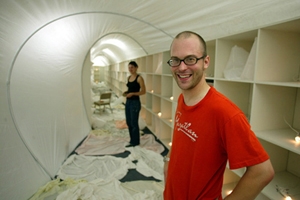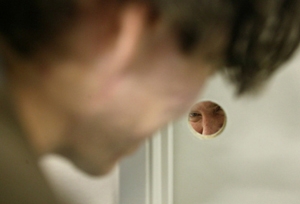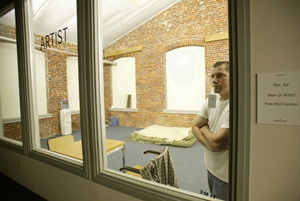Feature: Reviews
Something Tells Me It’s All Happening at The Zoo…
- Portland Center for the Advancement for Culture
- Portland, Oregon
- June 14 - August 31, 2003
In case you’re like me and didn’t make it to the Venice Biennale this summer, a terrific alternative would be to travel to Portland, Oregon, to visit The Modern Zoo. The brainchild of curators Gavin Shettler and Bryan Suereth, the exhibition features the work of more than seventy-five artists in all disciplines, including installation, painting, sculpture, performance, video, film, sound, and photography. Installed in the former Columbia Sportswear building – a rambling 100,000+ square foot warehouse and office space located in north Portland – the project includes numerous works by artists who chose to respond to the existing spaces in the building. It also features several small, media specific exhibitions. The centerpiece of these latter shows is Northwest Abstraction, which highlights the work of eight local abstract painters, such as Bob Jones and Lucinda Parker. It also includes Sculptural Clay, a selection of figurative ceramics including J.D. Perkins’ dynamic pairs of monumental heads and Jennifer Kenworth’s comical female figure “sitting” on the wall, forever trying to light the three cigarettes in her mouth.
The Modern Zoo is a project of Shettler and Suereth’s Portland Center for the Advancement for Culture (PCAC), and had its genesis in a convergence of social and cultural factors. As the curators explained, having grown up in a time of corporate build-ups and social breakdowns – including the government, the education system, and financial support for the nonprofit world – they felt the need to infiltrate the existing gallery system in order to re-envision it. Shettler believes the reclaiming of this corporate space to be not only a means to create a new alternative place for art, but also as part of building a “post-corporate identity.” Their use of the term “modern” indicates a break with the status quo and declaration of a new artistic direction – a “zoo” – with a variety of individual exhibits. The large number of genres, ideas and works on display reflect the eclecticism of the current artistic environment.
Consistent with this vision, the works range from traditional media to new genre projects, and mirror the fact that in today’s global art world, it no longer matters where one lives or works: the art and ideas are contiguous. This is especially evident in the preponderance of collective groups or collaborative pairs who created installations here. Some of their works are reinterpretations of earlier conceptual art ideas, like Steve MacDougall and Chris Rhoades’ Levitation Dream Fantasy, an installation space visually flipped on its side in the manner of Daniel Spoerri’s 1962 installation Dylaby; and Pete McCracken’s Man or Artist, which features the artist Dave Eckhard interred for the duration of the show in one of the glass-fronted former office spaces. McCracken’s work brings into focus the relationships between public and private, spectator and artist – or caged animal and audience. It also brings to mind the endurance works of artists like Linda Montano and Marina Abramovic.
Viewer participation is a strong component of many of these artists’ works. The preponderance of interactive works is an extension of what French curator Nicolas Bourriaud calls “relational aesthetics,” a methodology that includes an interest in social methods of exchange, the relationship between art and onlooker, and communication processes as tools to connect people. This mode also encourages congenial relations and situations where the artist assumes an alternate professional identity or creates work that transforms the gallery.
Such engaged relations are central to Natascha Snellman and Cynthia Star’s New Friend project, for which the artists interviewed visitors, provided costumes, and let them choose a landscape in which to be photographed; and the Ministry of Small Things, a show curated by a collective of twelve artists who reconfigured office space in order to create possibilities for viewer participation such as writing messages on manual typewriters.
Some collaborative groups inverted the nature of their spaces by creating wonderfully intimate interiors. These include Molly Roth and Emily Henderson’s The Snug, a maidenly “cozy quarantined interior space that will invite a pleasurable feeling of comfort…”; and The Bedroom Project, a formerly unassuming, cubicle-filled corridor transformed into an intriguing shrouded passageway filled with tiny lights, transparent pillows, and ethereal sound, by Jesse Kaminash, Jonah Groeneboer, Midori Hirose, and John VanBeers.Clearly, one of the significant motivations for some of these artists is the opportunity to be sensual and playful, particularly evident in works like Midori Hirose’s Tumble in the Grass, an inviting Astroturf mound that evokes children’s play equipment.
As complement to the great number of engaging works here, some artists created environments that are more deeply personal or political, and request contemplation. Among these are Rhoda London’s War Room, an installation that includes a series of semi-abstract, visually sensuous charcoal drawings in television screen format. The drawings are juxtaposed with text about the Gulf War, and hung over a table of current newspapers featuring headlines about the current Middle East insurgency, powerfully refocusing our understanding of these images. In another room is her equally moving installation By Hand, which concerns the essential and multifaceted use of our hands.
The pristine quality of the repetitive images of the artist’s hand writing on a table; rows of white gloves with tags hanging from each finger, stating things we might do with our hands in a day; and the unmortared brick wall that rises in one corner of the room; become a poignant milieu for the artist, who occasionally sits, knitting a growing length of white fabric, which she began with the inception of the war in Iraq. Equally political, albeit executed using very different methodology, is the documentation of Christopher Swain’s thirteen-month-long swim of the 1,243 mile length of the Columbia River, which he did to raise awareness of the poor health of its watershed and ecosystem. Because the river runs through Portland, such details as the artist’s need to stop every six hundred strokes to gargle hydrogen peroxide, reducing risk from toxin-producing microbes, heighten the personal nature of Swain’s very dangerous and political act.
Although these works are just a handful of the many that deserve mention, they are indicative of the fact that the art on display is consistently well conceived, executed, and installed. In keeping with the evolving and convivial nature of the project, the exhibition has three planned openings, the last of which will feature boat rides from the center of Portland’s gallery district to the Zoo. If you are fortunate enough to be ferried on the jet boat to this final opening, close your eyes and imagine it is up the Grand Canal to see an exhibition as far-reaching and inspiring as The Modern Zoo.
The Modern Zoo
A Project of PCAC
Portland, Oregon
June 14 - August 31, 2003



